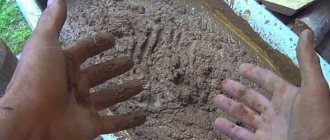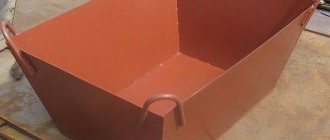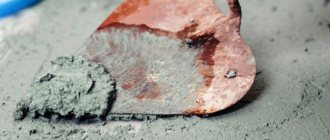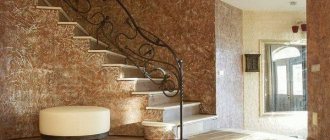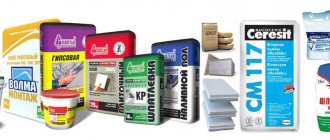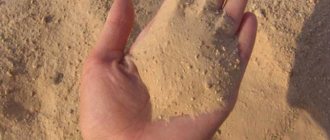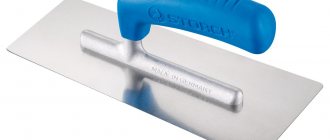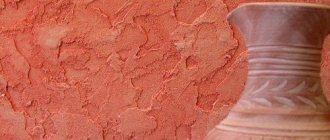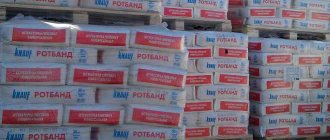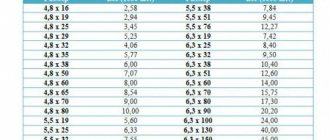Calculations of material costs in the form of dry mixtures.
At the very beginning of plastering work, a professional and an amateur need to decide on the amount of material required for successful work. A prerequisite for achieving the quality of the final result is to adhere to all the features of the technological process. You can give calculations using the example of such a parameter as the weight of dry plaster:
The average weight of one square meter of plaster is on average 15 kg. In order to find out more specifically, you need to multiply this weight by the thickness index. You can see an approximate calculation in the table below.
Weight of 1 m2 of plaster depending on thickness
| Plaster thickness | Weight 1 m2 (kg) | Specific gravity (kg/m3) |
| 1 cm | 15 | 1500 |
| 2 cm | 30 | |
| 3 cm | 45 | |
| 4 cm | 60 | |
| 5 cm | 75 |
Comparative characteristics of plaster solutions:
| Criterion / Plaster mortar | Plaster | Lime | Cement |
| Vapor permeability | 0.11-0.14 mg/mhPa | 0.10-0.12 mg/mhPa | 0.09 mg/mhPa |
| Consumption per 1 m², with a thickness of 1 cm | 8.5-10 kg | 12-20 kg | |
| Working time for hardening | 1,5 hour | 2 hours | |
| Working conditions | it is necessary to maintain optimal conditions | resistant to water and air | |
| The need for puttying | absent | Necessarily | |
| Moisture resistance | No | present | |
| Bactericidal properties | doesn't have | It has | |
| Strength | high | not high | |
| Versatility (external and external facades) | No | universal | |
Based on the data presented, we can say that all types of solutions have a number of advantages. They perfectly allow moisture to pass through without creating a “steam room” effect. The work process also has its own nuances, for example, the gypsum will have to be mixed more often in small portions, because it dries faster. Cement plaster can add heat capacity to a room, which is a significant advantage. When working in damp areas, it is necessary to use a moisture-resistant solution.
As for the cost, it varies depending on the material consumption. Thus, the specific gravity of cement-based plaster is 2 times greater than gypsum, and accordingly the weight of 1 m2 of plaster will be different. The price of gypsum mortar is higher, which means there will not be much difference in cost compared to a cement-sand mixture.
Source
Concrete mixtures based on M500 binder
To prepare your own concrete mortar based on the M500 binder, you will additionally need sand, sorted crushed stone, and water. The binder is suitable for the production of concrete grades M100-M500. The higher the marking of the concrete mixture, the greater the consumption of material required for preparation.
Table of proportions of components for obtaining a concrete mixture of a certain brand:
| Brand of concrete mix | Proportional composition: cement x sand x crushed stone | Composition (volume) per 10 liters of cement (l): sand x crushed stone | Amount of mixture (l) obtained from 10 l of cement m500 |
| 500 | 1×1,4×2,9 | 12×25 | 32 |
| 400 | 1×1,6×3,2 | 14×28 | 36 |
| 300 | 1×2,4×4,3 | 22×37 | 47 |
| 250 | 1×2,6×4,5 | 24×39 | 50 |
| 200 | 1×3,5×5,6 | 32×49 | 62 |
| 150 | 1×4,5×6,6 | 40×58 | 73 |
| 100 | 1×5,8×8,1 | 53×71 | 90 |
It is worth considering that long-term storage of cement reduces its technical performance. In three months, the binder will be of M400 grade. The shelf life of products in plastic bags (sealed) is 12 months. When packed in paper bags, cement can be stored for no more than 6 months.
Plaster weight
What do we want to learn today? How much does 1 cube of plaster, plaster composition, weight of 1 m3 of plaster - mixture for wall finishing weigh?
No problem, you can find out the number of kilograms or the number of tons at once, the mass of the construction mixture (the weight of one cubic meter of plaster composition, the weight of one cube of mortar for plastering walls, the weight of one cubic meter of bark beetle, the weight of 1 m3 of composition for finishing work) are indicated in Table 1. If If anyone is interested, you can skim the small text below and read some explanations.
How is the amount of substance, material, liquid or gas we need measured? Except for those cases when it is possible to reduce the calculation of the required quantity to the counting of goods, products, elements in pieces (piece counting), it is easiest for us to determine the required quantity based on volume and weight (mass). In everyday life, the most common unit of volume measurement for us is 1 liter. However, the number of liters suitable for household calculations is not always an applicable way to determine the volume for business activities. In addition, liters in our country have not become a generally accepted “production” and trade unit for measuring volume. One cubic meter, or in its abbreviated version - one cube, turned out to be a fairly convenient and popular unit of volume for practical use. We are accustomed to measuring almost all substances, liquids, materials and even gases in cubic meters. It's really convenient. After all, their costs, prices, rates, consumption rates, tariffs, supply contracts are almost always tied to cubic meters (cubes), and much less often to liters. No less important for practical activities is knowledge of not only the volume, but also the weight (mass) of the substance occupying this volume: in this case we are talking about how much 1 cubic meter of plaster mortar weighs (1 cubic meter of bark beetle, 1 cubic meter of mortar for plastering walls, 1 m3 of plaster). Knowing mass and volume gives us a fairly complete idea of quantity. Site visitors, when asking how much 1 cube of plaster composition for wall finishing weighs, often indicate specific units of mass in which they would like to know the answer to the question. As we noticed, most often they want to know the weight of 1 cube of plaster mortar (1 cubic meter of mortar for plastering walls, 1 cubic meter of bark beetle, 1 m3 of composition for finishing work) in kilograms (kg) or in tons (t). Essentially, you need kg/m3 or t/m3. These are closely related units that determine the amount of mixture for finishing walls. In principle, a fairly simple independent conversion of weight (mass) from tons to kilograms and vice versa is possible: from kilograms to tons. However, as practice has shown, for most site visitors a more convenient option would be to immediately find out how many kilograms 1 cubic meter (1 m3) of plaster - a mixture for plastering walls - weighs or how many tons 1 cubic meter (1 m3) of plaster - a building mixture weighs
, without recalculating the kilogram to tons or vice versa - the number of tons to kilograms per cubic meter (one cubic meter, one cubic meter, one m3).
Therefore, in Table 1 we indicated how much 1 cubic meter of plaster mortar weighs (1 cubic meter of bark beetle, 1 cubic meter of plaster) in kilograms (kg) and in tons (t). Choose the table column that you need yourself. By the way, when we ask how much 1 cubic meter (1 m3) of plaster composition weighs, we mean the number of kilograms of the mixture for wall finishing or the number of tons. However, from a physical point of view, we are interested in the density of the finishing composition or specific gravity. The mass of a unit volume or the amount of substance contained in a unit volume is bulk density or specific gravity. In this case, the volumetric density of the plaster mortar and the specific gravity of the plaster.
The density of a solution for plastering walls and the specific gravity of the bark beetle in physics are usually measured not in kg/m3 or in tons/m3, but in grams per cubic centimeter: g/cm3. Therefore, in Table 1, the specific gravity of the plaster and the density of the plaster mortar (synonyms) are indicated in grams per cubic centimeter (g/cm3)
Table 1. How much does 1 cube of plaster weigh, the weight of 1 m3 of plaster. Volume density of the plaster mortar and specific gravity of the composition for finishing work in g/cm3. How many kilograms are there in a cube of plaster composition, tons in 1 cubic meter of bark beetle, kg in 1 cubic meter of mixture for plastering walls, tons in 1 m3 of building mixture.
A few tips before starting work
After getting acquainted with the general technology of plastering internal and external walls, let’s move on to the nuances of the work:
- Plastering along beacons is a good way to level surfaces, however, working under the ceiling with this rule is not very convenient. But if you leave 10-15 cm uncovered, then leveling them the next day after the solution has dried will be easier. A new portion can be leveled not horizontally but vertically, which is pulled along the dried plaster;
- To prevent cracks from forming on the surface during rapid hardening and to prevent it from peeling off, the plaster is periodically sprayed with water from a spray bottle or the surface is protected with film. There should be no drafts or high temperatures in the room. If small cracks do appear, re-grout.
- It is very inconvenient to work with the rule in corners, niches or places where pipes pass. It can be replaced with a template of the required shape, made by yourself. In this case, the lighthouses are placed a little closer.
- The corners are aligned using a special metal corner, which you can also make yourself.
- You should not apply cement-sand mortar over gypsum or lime plaster: heavy plaster will simply tear off the weaker base.
- The proportions when mixing must be observed precisely: if there is an excess of cement (such a solution is called greasy), the coating will be very hard, but will crack as it shrinks. A thin mortar with excess sand produces a weak, loose plaster that crumbles easily.
- To determine the quality of the kneading, you need to turn the trowel over: the fatty mixture sticks too much, and the lean mixture drains quickly.
- With different coating thicknesses, due to uneven drying, it will look uneven in appearance. This is especially visible after painting. This defect also appears when applying plaster in a very thin layer.
We hope you found this article helpful, please leave your feedback and questions in the comments below.
Previous
Types of plasterPreparation of cement mortar for plaster: selection of material, proportions, mixing
Next
Types of plasterPlasticizers for cement mortars
How much plaster is needed for 1 m2? Determining consumption
When the walls of the house are completely prepared for leveling and measured, it’s time to purchase plaster mixtures. In this case, it is important to calculate everything correctly and, if possible, take care to reduce the plaster layer to an acceptable minimum.
What does consumption depend on?
It must be indicated by the manufacturer on the bag or plastic container. However, these characteristics are quite approximate and can have a spread of 1-2 kg/m2. After all, all the compositions are quite different, and their specific gravity differs even within the same group of products for different brands. For preliminary calculations, you can use approximate figures.
The consumption of cement-sand plaster is very high: up to 18 kg for the Osnovit brand and about 16 kg for Litokol. The cement Knauf Diamant and Bergauf differ in average weight in terms of m2, and Keraflex has the smallest - only 15.5 kg.
Average figures for light gypsum paste are from 8 to 10 kg per square centimeter thick. Knauf Rotband and Prospectors have the minimum share. The average consumption of Rotband gypsum plaster per 1 m2 is 8.5 kg. Bau Putz from Bergauf is considered the heaviest - up to 13 kg/m2 with a thickness of one centimeter.
For gypsum mortars of the Rotband type, which have to be applied in a particularly thick layer, consumption is of great importance. For example, most walls in panel houses have to be leveled by 3-5 cm. That is, each square will take a whole bag of Rotband.
The thickness of the required layer of solution will be determined by height deviations at different points on the surface, but this value can be adjusted downward. To save a decent amount of plaster mixture, large protrusions should be cut off.
Preparing the walls
To avoid peeling of the heavy cement mixture from the walls, it is necessary to pre-prepare the surface.
There are several ways: Apply a small layer of tile adhesive to the wall . It is used as an intermediate layer between cement plaster and the wall. Thanks to the additives in its composition, the adhesive has good strength and adhesion. A plaster mesh is placed on top of it, completely covering it. The edges of the mesh should overlap 10 cm. Next, use a notched trowel to smooth out the mesh and embed it in a layer of tile adhesive. After this, horizontal grooves are left with a spatula. When the adhesive solution dries, it will become a solid base for leveling cement-sand plaster.
Reinforcement with metal plaster mesh , rigidly fixed to the wall with self-tapping screws. This is done when it is necessary to plaster fragile surfaces, as well as wooden and clay walls, with a thick layer.
On concrete walls, notches are made over the entire surface . For this, a hammer drill or an ax is usually used. After this, an adhesive primer is applied, for example Betonokontakt.
Wire sheathing is another option for strengthening the wall. Self-tapping screws are screwed into the wall at equal distances or nails are driven in and tied with wire. It turns out to be something like a metal mesh, which is then plastered. This is an inexpensive but labor-intensive method that is more suitable for repairs in small areas.
Before plastering, the old plaster is tapped, loose pieces are removed, and the pits are cleaned with a brush.
The walls of their aerated concrete and other cellular concrete blocks are usually smooth and do not require special preparation. They are treated with a deep penetration primer to reduce the absorption of water from the plaster mortar. Dehydration of cement plaster will lead to its accelerated setting, and this will reduce the strength of the hardened layer.
Tips and tricks
On porous and highly absorbent surfaces, in order to reduce consumption per m 2 with a thickness of 1 cm of the plaster mixture, you need to use special insulating primers. They will not allow moisture from the solution to be absorbed into the base, weakening the plaster layer, and will provide more reliable adhesion to the wall.
To determine as accurately as possible the size of the plaster layer to level the wall, it is better to take measurements after marking and installing the beacons. Having found out the “depth” of the future coating at several of the most problematic points, the measurement results should be added up and divided by their number. The more measurements are taken, the more accurate the result will be.
For each surface, the thickness of the plaster layer is calculated separately. In this case, you need to add the height of the beacon profile - 6-10 mm. That is why it is recommended to install beacons in the “lowest” sections of the wall in order to reduce consumption by 1 m 2.
No matter how accurate the calculation is, inconsistencies in theory and practice may appear during the work process. Therefore, when purchasing, it is still better to take 5-10% more mixtures than you are supposed to use.
Preparation of the solution
To finish small surfaces, it is much easier to buy a ready-made dry cement-sand mixture. For larger amounts of work, it is more profitable to prepare it yourself. The most important thing is to accurately observe the proportions.
First, sand and cement are thoroughly mixed without adding water. The mixing proportions will depend on the brand of cement. The resulting cement plaster according to GOST is divided into several grades:
Even the cleanest sand must be sifted through a sieve to remove small inclusions. It is undesirable to use cement that has been stored and caked for too long. If necessary, it can be sifted, removing hardened lumps, and the amount of sand in the solution can be reduced by 1/4.
The liquid is added after mixing the dry ingredients. It is added in small portions, thoroughly mixing the solution each time.
To increase its plasticity and mobility, plasticizers are introduced into it. We have already mentioned this above. The finished solution should be collected in a slide and not spread, while being well distributed over the surface.
Read more about preparing sand-cement mortar for plaster here.
Density of construction waste
Different types of waste also have different densities (mass to volume ratio). So, for example, the density of polyurethane foam is much less than the density of concrete, that is, of two containers of the same volume, one of which is filled with concrete and the other with foam, the container with concrete will be heavier.
Important! The carrying capacity of any vehicle is limited, as is the volume of containers, which means that the higher the accuracy of calculations of the weight and volume of transported cargo, the higher the likelihood of saving time and money.
Knowing the density of garbage is necessary to calculate its volume or mass. This data is needed to calculate logistics schemes: what carrying capacity of vehicles will be used and how many cars (or flights for one car) will be needed, what volume of containers will be used.
For convenience of calculations, general averaged density values for different types of structures are accepted:
- concrete - 2.4 t/m3;
- fragments of brick and stone, tiles, external tiles, waste from removing plaster—1.8 t/m3;
- wood, frame structures with backfill - 600 kg/m3;
- other construction waste (except for engineering, technological and metal structures) - 1200 kg/m 3 .
reinforced concrete - 2.5 t/m3;
Important! The calculation of the mass and density of engineering and technological structures and metal products is calculated in accordance with the information specified in the design documentation.
The above data refers to buildings “in a dense body,” that is, not disassembled. The actual density of disassembled structures will differ (t/m 3):
- mixed waste (dismantling) - 1.6;
- mixed waste (repairs) - 0.16;
- pieces of asbestos - 0.7;
- broken brick - 1.9;
- ceramic products - 1.7;
- sand - 1.65;
- asphalt road surface - 1.1;
- insulation (mineral wool) - 0.2;
- steel products - 0.8;
- cast iron products - 0.9;
- plaster - 1.8;
- crushed stone - 2;
- fibreboard, chipboard - 0.65;
- wood (window and door frames, baseboards, panels) - 0.6;
- linoleum (trimmings) - 1.8;
- roofing material - 0.6.
What is Izover façade?
Isover facade is a universal insulator and consists of stone wool. With a plaster facade, isover serves as thermal insulation, and in SFTK it also acts as sound insulation. Thanks to the cutting system, these types can be divided into fragments of different shapes, including in the form of standard cut strips. The insulation is suitable for such types of systems as thick-layer and thin-layer.
Mineral wool isover characteristics
The density of Izover façade slabs is well suited for cutting; they can be cut and installed without much effort even in one working day. Just like other materials, slabs can be made to order in the required proportions, but the standard sizes are as follows:
- Length – 1200 mm;
- Width – 600 mm;
- Thickness –50; 100; 150mm.
The characteristics of Izover slabs are quite good, which allows them to be head and shoulders above many thermal insulation analogues. These slabs are very rigid, which allows them to retain their original shape even over a long period of use. Density is 145 kg/m³. Izover also has good indicators for the tensile strength of layers, which is at least 15 kPa.
Weight of a cubic meter of construction waste
To find out the mass of a cubic meter of construction waste, you need to refer to the average density data presented above. Density shows how much mass a given volume of the desired material has. For construction waste “in general,” the average density is equal to 1.6 t/m 3 for mixed demolition waste, and 0.16 t/m 3 for renovation waste. That is, one cubic meter of mixed waste from demolition will have a mass of 1.6 tons (1600 kg), and from renovation - 0.16 tons (160 kg). The mass per cubic meter of other types of waste can also be easily calculated using their corresponding density values.
It’s worth turning to these same values if the question arises: “how to convert construction waste from cubic meters to tons?” Knowing the density and volume of a certain type of waste, you can calculate its mass by multiplying the density by the volume.
Roof thermal insulation
- For work on insulating roofing systems, a number of basalt insulation materials with a density of 37 kg/m 3 or more
. - In addition to heat preservation, lightweight basalt wool has effective noise absorption and stable performance characteristics throughout its half-century service life. The material does not tolerate deformation loads well. In a compressed state, its thermal conductivity increases significantly.
- There are exceptions: certain types of light insulation are supplied to the retail chain in a 60% pressed state. After opening the packaging shell, the material is completely restored to its original volume with full preservation of its working properties.
Specific gravity of construction waste
Specific gravity is the ratio of weight to occupied volume. Specific gravity is measured in N/m³ and is calculated using the formula mass (kg) * 9.8 m/s 2 / volume (m 2 ). For four cubic meters of waste with a total mass of one ton, the specific gravity will be equal to:
1000 kg * 9.8 m/s 2 /4m 3 = 2450 N/m³
Note! In everyday life, for us there is no difference between weight and mass; we are accustomed to the question “what is your weight?”, but when making calculations it is important to remember that weight and mass are different physical quantities. Mass is measured in kilograms (kg) and weight is measured in Newtons (N)
Other units of measurement are also used to indicate specific gravity:
- SGS system - dyn/cm 3 ;
- SI system - N/m 3;
- MKSS system - kg/m 3.
To convert N/m 3 to other units, you can use the ratio: 1 N/m 3 = 0.102 kg/m 3 = 0.1 dyne/cm 3 .
Important! Although the values for density and specific gravity may be the same in some cases, it must be remembered that specific gravity is measured in N/m 3 and density in kg/m 3 .
How to count construction waste from a dismantled building
You can preliminarily calculate the amount of construction waste during demolition using the following method:
- Determine the building volume of the building in a “solid body” by multiplying the length, width and height of the house, taking into account the foundation and roof.
- Calculate the actual volume of waste for removal by multiplying the construction volume by the loosening coefficient equal to 2.0.
- Calculate the mass of waste being removed by multiplying the volume of the building in the “dense body” by the density of the waste type.
- Depending on the resulting mass, determine the number of containers or vehicles (based on their carrying capacity) that will be needed to remove waste for recycling.
Characteristics of cement, its chemical formula
Materials scientists classify building materials such as cement as artificial inorganic binders. With liquid materials, it is capable of forming a mass that has plasticity, the ability to harden and take on the shape of a stone-like body.
Most often, cement is used to prepare concrete and various solutions for construction. There are many different types of this material, differing in their characteristics, application, as well as physical and operational properties.
The formula of cement is quite complex, since the chemistry of this substance is multicomponent and complex. In most cases, the material consists of the following substances :
- CaO (calcium oxide) – 67 percent;
- SiO2 (silicon dioxide) – 22 percent;
- Al2O3 (aluminum oxide) – 5 percent;
- Fe2O3 (iron oxide) – 3 percent;
- other components – 3 percent.
Based on the list of components, we can conclude that the chemical formula of cement is large and quite confusing. Thanks to this composition, the material has many useful qualities.
Certain characteristics allow them to be assessed, the most important of which experts include the following:
- bulk density of cement;
- specific density of cement;
- strength indicators;
- setting and hardening time;
- specific gravity;
- resistance to low temperatures;
- grinding fineness;
- material consumption;
- corrosion resistance, etc.
The above characteristics of the material are quite important. They may vary slightly depending on conditions, which requires a careful approach to calculations. The first two indicators can significantly affect the determination of the amount of cement required for the construction of certain objects.
In general, the density of the binder is in the range from 3000 to 3200 kilograms per cubic meter. But these are only average statistical data, which may differ depending on many factors.
Specific gravity of plaster and volumetric weight calculation table
Aligning walls inside and outside a room is a complex and time-consuming process. Moreover, the final result directly depends on the material the master uses. The construction products market offers a wide range of plaster mixtures. The most common are:
- Plaster.
- Calcareous.
- Cement.
- Combined (arrangement of 2 or more types). When choosing the right material, it is necessary to take into account the functional features of each type.
The principle of applying gypsum putty and its types
Author: Anastasia Isakova · Published 08/12/2017 · Updated 01/27/2018
One of the important points during renovation is preparing the walls for decorative finishing. Gypsum putty will help make the walls even and smooth. The gypsum included in its composition is an environmentally friendly and safe substance that can be used to repair residential premises. Today, the construction market has a huge selection of putties from companies known for their quality: Knauf, Weber Vetonit, Volma.
Calculations of material costs in the form of dry mixtures.
At the very beginning of plastering work, a professional and an amateur need to decide on the amount of material required for successful work. A prerequisite for achieving the quality of the final result is to adhere to all the features of the technological process. You can give calculations using the example of such a parameter as the weight of dry plaster:
The average weight of one square meter of plaster is on average 15 kg. In order to find out more specifically, you need to multiply this weight by the thickness index. You can see an approximate calculation in the table below.
Prices and material consumption
For this type of work, it is important to correctly calculate the amount of material required. The surface area for insulating a plaster facade must be calculated as follows: the perimeter is considered, excluding the openings of the outer lining of the box.
The price of the material depends on the form of release. On average, mineral slabs and rolls do not differ much in cost, so you need to choose based on the type of work. It is worth considering that the price of the Izover plaster facade is higher than the cost of a similar product. But this can easily be explained by technical indicators and service life, which reaches 50 years.
Weight of gypsum plaster
To determine the volume of various substances, it is customary to use cubic meters. Other parameters are tied to this unit of measurement, such as:
- packaging price;
- consumption of dry mixture and solution;
- execution of a supply agreement.
The weight of gypsum plaster on the packaging is indicated in kilograms. In rare cases, the concept of liter is used.
Application of the composition
First, you should remove the old finish, if any, clean and degrease the base if necessary, and apply priming.
The next step is to prepare a solution of gypsum putty by mixing the dry suspension with water in accordance with the proportions indicated on the packaging. Then the mixture is kept for 5-7 minutes. and mixes again.
For direct application to the prepared surface, metal spatulas of different sizes and rules are used. It is advisable to sand the hardened layer.
Even the variety of modern putty mixtures does not allow us to displace gypsum putties for interior work from the first place in consumer preferences, because for a very attractive price the consumer is offered an ideal composition endowed with a whole arsenal of advantages.
Weight standards for gypsum plaster
When working with any materials, knowing only their volume is not enough: when receiving a solution, the volumetric weight of gypsum plaster is an important indicator. If we talk about gypsum plaster and its physical parameters, then knowing the mass and volume of the building material, you can easily imagine how much of it we are talking about. In questions about the weight of plaster, the size of a cubic meter is also meant. To indicate the weight of plasters, it is usually customary to use kilograms or tons (kg/cm3, t/cm3). The density of the solution has its own unit of measurement - g/cm3. It was determined that the mass of one cubic meter of solution is 1.5 tons, that is, the specific gravity of gypsum plaster is 1.5 g/cm 3 .
Cement sand mixture for plaster
We are constantly updating its content with new data. In this table we have collected information on the density of wood of almost all species presented on the Russian market. Weight is also calculated using the above formula. Often, when planning an apartment renovation or building a house, it is necessary to calculate the weight of building or finishing materials.
This is not so difficult to do, knowing the density of the materials.
Types and thermal conductivity
Below are two tables. Formula for calculating the weight of building materials.
Density of basic materials in construction and finishing. Density of the main wood species. Any calculations using online calculators are indicative only. Their results cannot be used in the preparation of any project documentation, see
How to calculate plaster consumption
Experts suggest using two methods for calculating needs:
First: to calculate the required amount of plaster that will be needed to carry out repair or basic finishing work, the following are used:
- the area of all walls to be repaired in each room;
- data on the curvature of each wall;
- information on the yield of the solution of the finished mixture, which is obtained by diluting with water;
- a burden that will additionally fall on the walls.
The thickness of the plaster should be no more than 4 cm.
Data on the first two indicators are of great importance, because many compositions cannot be laid in one layer. The maximum permissible thickness is 3-4 cm. If there is a need to use a thicker layer, the wall is pre-reinforced using a special metal or fiberglass mesh. With this preparation, the thickness of the applied layer can be 5-7 cm.
When calculating the need for the finished solution, it should be borne in mind that in the instructions that are attached, all calculations are based on the thickness of 1 mm of the applied layer. Therefore, knowing how many square meters of space one package is designed for, it is easy to calculate its actual need. To determine the need for a dry mixture, use the following formula:
In addition, one should take into account such an indicator as the weight of plaster per 1 sq.m. For example, the weight of certain types of plaster reaches from 8 to 10 kg per square meter, and if the thickness of the layer increases several times, the weight of the plaster increases accordingly.
Second: the instructions contain data on the amount of the finished mixture that will be obtained when diluting the dry composition, as well as the amount of water required for this.
We need to calculate the amount of dry mixture. For this:
- we calculate the area of the working surface that is to be covered with the solution, multiply it by the average thickness of the plaster, as well as the consumption coefficient of the finished mixture;
- we multiply the obtained result by the amount of water recommended by the manufacturer of the dry mixture that is necessary to prepare the solution;
- From the amount of solution that came out, we subtract the amount of water needed for a given volume of solution.
Advantages and disadvantages
The main advantages of cement compositions include:
- increased durability of the coating: unlike gypsum, it is not so easy to chip or crumble such plaster;
- resistance to temperature and humidity fluctuations;
- durability: even when finishing facades that are most exposed to adverse weather conditions, waterproof cement-sand plaster can last up to 15 years or more without repair;
- high adhesion to most types of surfaces, including concrete, brick, cinder block, stone;
- ease of making the solution: it can be prepared even at home by simply mixing cement with sand and water in the required proportions;
- affordable price: ready-made DSP plasters are 15-20% cheaper than gypsum plasters, and if you mix it yourself, the price will be 2-3.5 times lower.
But cement-based coatings also have a number of disadvantages:
- it is difficult to work with heavy viscous mortar and level it;
- the surface turns out to be rough, so it requires applying an additional finishing layer of gypsum if you plan to paint the wall or wallpaper;
- cement-sand mortar makes the walls heavier, so the load on the foundation will also increase;
- poor adhesion to painted and wooden surfaces;
- It is not recommended to apply cement plaster to plaster - a heavy layer will simply tear it off;
- it shrinks, so if you apply too thin a layer it can crack; The minimum layer is 5 mm, the maximum is 30 mm. If a thicker leveling coating is required, it is applied with mesh reinforcement, plastering 2-3 times, drying each layer.
Consumption of various types of decorative plaster
Quite often, bark beetle is used when finishing the surface of walls. Since the solution contains crumbs. When applied to the surface, the composition takes on the appearance of a relief coating, which is very similar to tree bark eaten away by a bark beetle.
The thickness of the applied coating depends only on the size of the crumbs that are part of the solution. The larger the crumb, the thicker the applied layer and the larger the pattern. All detailed information about the consumption of plaster is in the instructions, but with a layer of 1 cm, the consumption of decorative bark beetle plaster per m2 will be from 2.5 to 4 kg.
It is recommended to procure 5% more of the calculated quantity.
Venetian plaster
Venetian plaster is an equally popular finishing material. It is characterized by a very thin layer of decorative coating. It is not suitable for smoothing out individual wall irregularities. With its help, an imitation of the finishing coating is made to look like stone, wood, and a basis is created for the production of frescoes.
Before using the solution, preparatory work should be carried out. The surface to be coated must be perfectly flat, since after applying the composition all defects on the wall will be visible, so the surface is carefully puttied, sanded and coated with two layers of primer.
After the primer has dried, the finishing mixture is applied in two layers using arched or scattered movements, trying to do the job more or less evenly.
After the mixture has completely hardened, the surface is polished with zero-size sandpaper and coated with a special wax composition.
The mixture consumption is minimal due to the thin layer of applied solution. Usually per 1 sq.m. 70 to 200 grams are consumed. dry composition.
In its final form, Venetian plaster will reflect everything like a mirror.
What is the consumption
Plastering work requires a certain amount of material; correct calculation of costs ensures the cost-effectiveness of layer formation.
The main factor that affects the consumption of the plaster mixture is the thickness of the layer. It is determined based on the level of unevenness on the surface. In new buildings, deviations are usually approximately 20 mm, rarely more. In most cases the layer varies in thickness from 6 mm to 20 mm.
Taking the average value of 13 mm, a flow rate of 15 kg/m2 is ensured. In practice, 1 bag of mixture should be enough to treat 2 m2 of surface, but the ability to use the composition and minimizing unused mixture also plays a role here.
Naturally, the consumption of mixtures is an imprecise value and can fluctuate greatly. If sand-cement plaster seems like an overwhelming task, you should contact specialists who can more reliably determine the amount of resource spent, especially important for large areas. Specialists can perform plastering by machine; this option has a number of advantages and will help save money or, at least, not overpay by saving material.
Texture for decoration
One of the ways to decorate walls that do not have an ideal surface is to use textured decoration. This type of finishing allows you to hide all defects and uneven surfaces. Textured plaster is a fashionable trend in finishing work.
To create texture, specialists use a simple roller covered with lint. The creamy mixture is applied with a roller to the wall and creates a unique pattern. You can use a roller with a pattern or ornament applied to its surface.
In addition, special stamps are used that contain original designs or images of ornaments on the working surface. By applying it to the wall, the design is transferred from the stamp to the surface.
The easiest way to apply textured plaster is with a spatula, trowel and brush. With such tools, the texture of wild stone is repeated, various designs and original, non-repetitive patterns are created manually. For more information on how to make plaster calculations, watch this video:
After finishing the work, the surface of the wall is primed and several layers of paint are applied.
Areas of application of cement plaster
Cement mortar adheres well to brick and concrete, filling even small potholes. The coating is quite smooth, without cracks or large defects.
Cement-based plaster is used for the following work:
- facade finishing;
- plastering and leveling surfaces in rooms without heating (balconies, loggias) or rooms with high humidity (bathrooms);
- sealing seams and cracks of external and internal walls;
- leveling surfaces with large defects and large dips;
- preparing walls for tiles.
By the way, in damp rooms mold or mildew may appear on unfinished cement plaster. In this case, the walls are etched with a neutralizing solution.
For stone and wooden surfaces it is better to use cement-lime mixtures. Ordinary sand-cement ones will not stick to them well.
